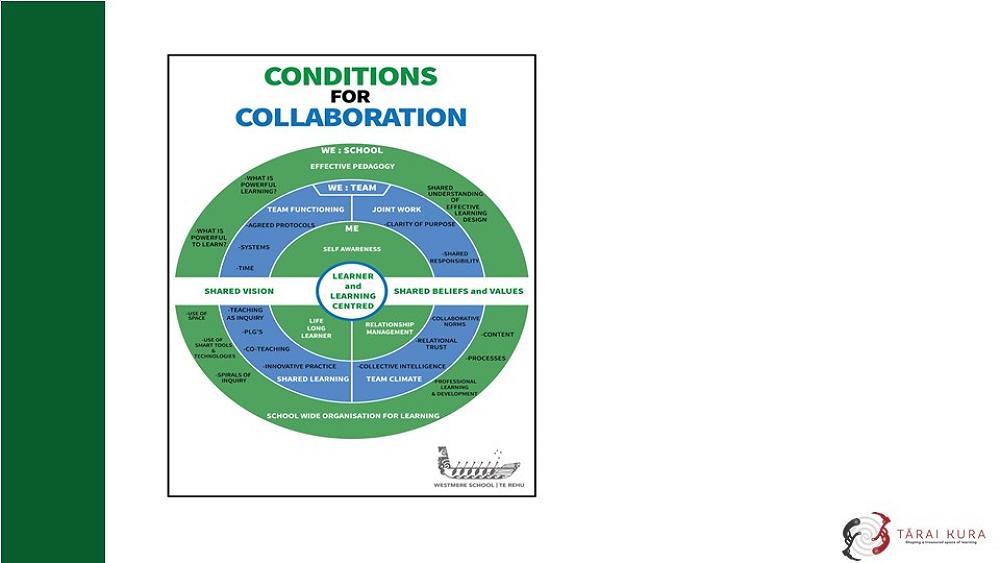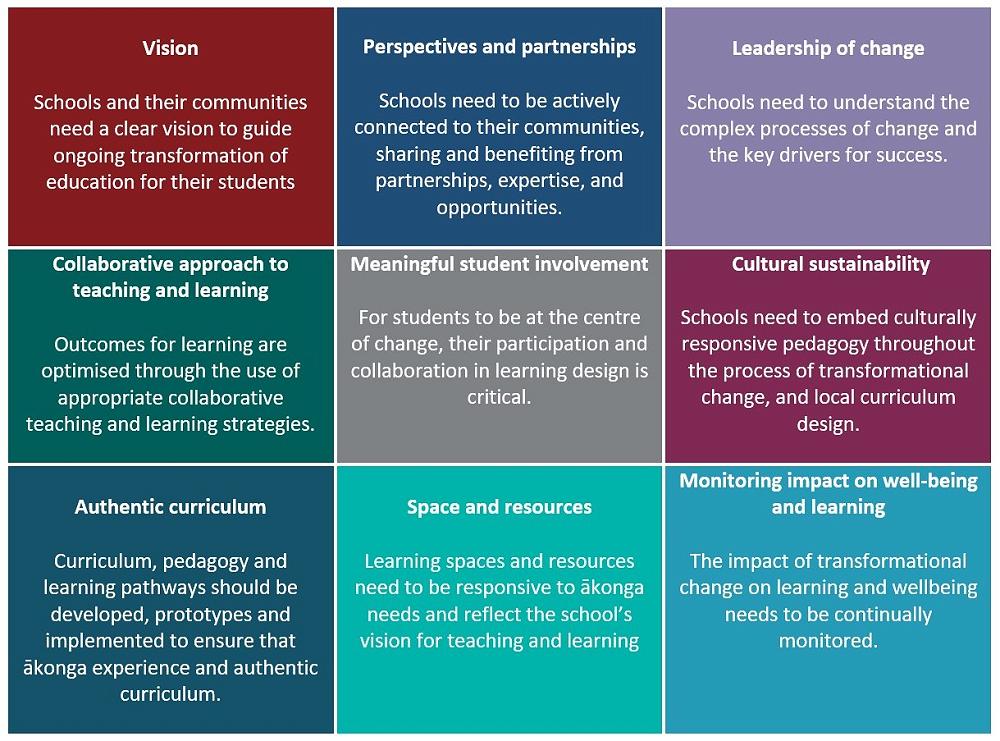
Community of Practice: Looking back on our year of learning together
As part of the networking opportunities we offer to Tārai Kura schools, this year we ran a Community of Practice focused on Collaborative Approaches to Teaching and Learning. 30 school leaders and kaiako from 8 schools met once a term for a day to learn and create new knowledge together. Throughout the year within school teams then shared ideas and trialled new approaches in their own contexts.
By definition, A community of practice (CoP) is a group of people who share a concern or a passion for something they do, and learn how to do it better as they interact regularly.” Etienne Wenger
For newly established schools and those undergoing major redevelopment, the opportunity to engage with other schools and challenge their own thinking was well received.
“ I enjoyed the chance to hear other’s journey and to coach each other.”
“I liked the opportunity to visit another school and having time to chat with our own team, to make sense of what we are seeing and how it relates to our context.”
I liked being challenged with new ideas and the coaching was really valuable; I’d would like more of it!” COP members feedback.
HUI 1: Considering the conditions for collaboration to succeed
In term 1 COVID prevented us from meeting kanohi-ki-te-kanohi, so our first meeting was online where we spent time getting to know each other and establishing our norms and expectations for working together. The year’s focus was set with an interactive session based around the provocation: Why collaborate?
In a session entitled “The big picture: Considering the conditions necessary for collaboration to succeed,” one of our Ringa Whao, Carolyn Marino, provided the provocation by sharing her experiences and learning as a Principal leading a large primary school through a major rebuild.

This set the scene for each school to undertake a self review of their current reality and to establish an inquiry focus to channel their learning over the year.
Hui 2: Learning design through collaboration
Our second hui was held at Hobsonville Point Secondary School and principal Maurie Abraham and DP Di Cavallo set the scene for a lively day of dialogue, inquiry and reflection.
Maurie challenged us to consider the dispositions of leadership needed to navigate through transformation.
“I believe an effective leader must have a clear personal moral purpose and has to promote a collective moral purpose amongst staff students and whanau.
However, without the accompanying element of courage then little action arises from the moral purpose. Finally, being open to learning means that while an effective leader will have strong views on issues and on the actions of others, they must be open to the fact that they might be wrong.
I believe that it is the intersection of all 3 elements where truly effective leadership of innovation occurs.”
Following a tour of the school in action, Di used the metaphor of the art of Tivaevae, to explore the way HPSS designs for learning with collaboration firmly drive all interactions.
A fia vave oo lou va’a, alo na o ‘oe, ae a fia tuli mamao le taunu’uga tatou ‘alo’alo faatasi.
If you want to go fast, go alone; if you want to go far, go together. (Samoan proverb)
Why Tivaevae?
Tivaevae is a traditional social and cultural activity - a collaborative activity involving exchange of ideas and collective application of skills and knowledge to advance and align something.
The school draws on this metaphor in the way it works:
COLLECTIVE EFFORT & COMMUNICATION through TĀ’OKOTAI (collaboration) towards ‘AKAIRI KITE (shared vision)
CoP participants really loved this day and shared these reflections.
“ I have a lot of the questions about collaborating with the department, across departments, students and whānau before I went to the PD day, and I have a better understanding with a clearer picture how collaboration can be done."
"Firstly, absolutely wonderful to finally be able to meet in person - so much easier to connect and participate in meaningful discussions in person! I appreciated the opportunity to visit another school and listen to their journey - being brave is an important message for kaiako and tamariki! Having time to chat with our own people throughout the day was also very valuable. It is often very difficult to get us all in one place at the same time." CoP members
Hui 3: Vision for learning ++
In Term 3 we were welcomed by Chris Bradbeer to Stonefields School where he shared the school’s strong vision for learning that underpins all processes and practices across this highly collaborative school. Our team enjoyed the opportunity to see the 3 iterations of build design the school has experienced over 12 years of growth. The last iteration, strongly influenced by ākonga voice and input was especially thought provoking, and we enjoyed the insights of our Year 8 guides who shared their experiences of learning in their school.
One of the highlights of our days together is the time taken in the afternoon session to unpack the learning we have done in our schools between visits. Through a peer coaching process, school teams had a chance to share their inquiry dilemmas with another school team, and be deeply listened to. For many of our community, this deep listening was one of the greatest gifts, where dilemmas of practice were talked through and careful questioning allowed new insights to emerge.
“ It was good to have the opportunity to have time to coach with another school and find solutions to any of our challenges.”
“Great to hear of different experiences and perspectives. Lots to consider and think about.”
Hui 4: Student lead curriculum
In torrential rain our final visit was to Ormiston Junior College, where Leaders of Learning, Luke Sumich and Viv Mallabar shared their journey as a new school founded in 2017. The focus of this day was exploring the development process that the College went through to design a student lead curriculum through and incorporating collaborative practice.

Through careful unpacking of the NZC and reading best evidence research, the school has developed a curriculum founded on a set of key principles:
1. Authentic inquiry and robust learning design (individual and group)
2. Knowledge creation that is transdisciplinary
3. School and home partnerships that are focussed on learning
4. Real world experiences (exposition, expedition, internship, service)
5. Highly collaborative processes (within teaching teams and diverse communities)
6. A powerful learner advisory (Learners are always at the centre)
To see how students drive their own assessment through the badge bidding process was inspiring and stimulated our afternoon’s reflections. Of course, listening to the ākonga themselves was very convincing of the place for increased student agency in our decision-making processes.
“At first doing the badges was tricky until we had a go and saw how other students were bidding, completing criteria and levelling up their badges. By the end of the first year, I can see how using the badges forced me to think about my learning an to plan to meet goals and criteria each week. Watching and helping to decide the level for other kids badges was also great learning for us all, and we can all see our strengths and help each other improve and meet the criteria in ways that work for each of us.” Alicia Choo,Year 9 Student
Final reflections
In a year of continual COVID disruptions we (Ringa Whao) were so impressed by the commitment of the schools involved, ensuring as many of their team could attend these days. This often meant senior leaders covering classes and for this we sincerely thank our schools for their commitment to this networking and learning community. With the pressures of ongoing change it is so important that we find ways to NOT reinvent the wheel and look to network, learn and grow together for the common purpose of improving learning for each of our ākonga.
Looking forward to 2023
After reviewing Te Whao (MEF tool, see below) key areas of interest have emerged for a 2023 COP:
- A focus for both primary and secondary schools around student involvement and collaboration with students and teachers, through a culturally responsive lens.
- A focus for our secondary schools around exploring shifts in pedagogy, curriculum, systems and structures to support transformation.

- Watch your inboxes in January requesting your expression of interest to join a community of practice in 2023!
